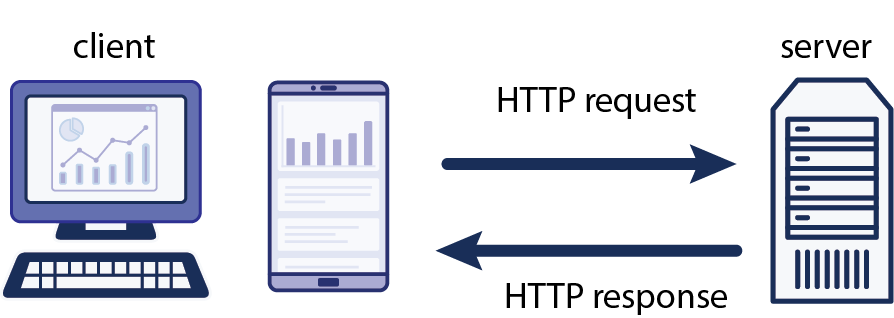Web Apps
- Press O or Escape for overview mode.
- Visit this link for a nice printable version
- Press the copy icon on the upper right of code blocks to copy the code
Class outline:
- How the web works
- Server-side Python
- CS61A projects
How the web works
Clients and servers

HTTP
A client sends an HTTP request:
GET /index.html HTTP/1.1
Host: www.example.com
The server sends back an HTTP response:
HTTP/1.1 200 OK
Content-Type: text/html; charset=UTF-8
Content-Length: 208
<!DOCTYPE html>
<html>
<head>
<title>Example Domain</title>
</head>
<body>
<h1>Example Domain</h1>
<p>This domain is to be used for illustrative examples in documents.</p>
</body>
</html>
Webpages
Webpages are made up of three languages:
- HTML: Contains the content and uses tags to break it into semantic chunks (headings, paragraphs, etc)
- CSS: Contains style rules that apply properties to elements on a page.
- JavaScript: Contains code that dynamically accesses and updates the page content to make it more interactive.
What does a server do?
The most basic server just serves up HTML and multimedia files from a file system.
Server-side code is also useful for anything that requires access to persistent data or needs an additional layer of security than allowed in the client.
- User authentication
- Database fetches/updates
- Caching
Server-side Python
Simple HTTP server
From the standard library, the http module can run a basic server. But it is not recommended for production.
Running a simple file server:
python -m http.server 8000
Demo: Simple dynamic pages
Using the http module to dynamically generate responses.
simpleserverexample.pamelafox2.repl.co/path
View the code by clicking the "Code" tab at https://replit.com/@PamelaFox2/SimpleServerExample
Based on this code.
Flask framework
An external package, Flask is a lightweight framework for server requests and responses.
Apps written in Flask:
- cs61a.org
- Khan Academy (originally)
- Netflix
Demo: Simple Flask website
Using the Flask framework to generate responses for each routes.
simpleflaskexample.pamelafox2.repl.co/
View the code by clicking the "Code" tab at https://replit.com/@PamelaFox2/SimpleFlaskExample
Based on this tutorial.
Webapps with Databases
Web apps store any data in databases that needs to be shared across multiple users/computers.

Demo App: Native or Not?
flaskdbexample-orm.pamelafox2.repl.co/
View the code by clicking the "Code" tab at https://replit.com/@PamelaFox2/FlaskDBExample-ORM
Demo App: 61A Merch
61amerch-orm.pamelafox2.repl.co/
View the code by clicking the "Code" tab at https://replit.com/@PamelaFox2/61aMerch-ORM
Django framework
An external library, Django is a fairly heavyweight/opinionated framework for server-side code. Includes an ORM for database interaction.
Apps written in Django:
- Coursera (originally, now Scala+Play)
- Pinterest (originally, now Flask)
- Eventbrite
CS61A projects
Common files
Hog and Cats both use the http module to run a server and share common files for setting up the server.
common_server.pyCats code
The Cats code includes many routes for handling multiplayer games, since those require access to the database.
multiplayer.pyHog code
The Hog code includes routes for taking the next turn. It does not store anything in a database, the browser just remembers all the turns.
hog_gui.py